 W
WAmigaOS 4 is a line of Amiga operating systems which runs on PowerPC microprocessors. It is mainly based on AmigaOS 3.1 source code developed by Commodore, and partially on version 3.9 developed by Haage & Partner. "The Final Update" was released on 24 December 2006 after five years of development by the Belgian company Hyperion Entertainment under license from Amiga, Inc. for AmigaOne registered users.
 W
WA new version of AmigaOS was released on December 24, 2006 after five years of development by Hyperion Entertainment (Belgium) under license from Amiga, Inc. for AmigaOne registered users.
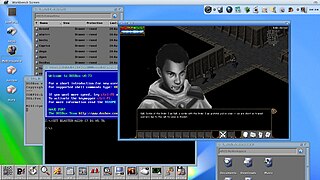 W
WAROS Research Operating System is a free and open-source multi media centric implementation of the AmigaOS 3.1 APIs. Designed to be portable and flexible, ports are currently available for x86-based and PowerPC-based PCs in native and hosted flavors, with other architectures in development. AROS, in a show of full circle, was also ported to the m68k-based Amiga 1200, and there is also an ARM port for the Raspberry Pi series.
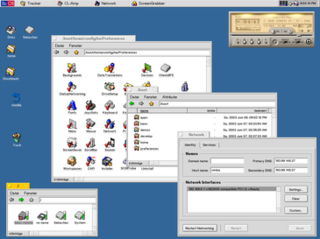 W
WBeOS is an operating system for personal computers first developed by Be Inc. in 1990. It was first written to run on BeBox hardware.
 W
WFinnix is a Debian-based Live CD operating system, developed by Ryan Finnie and intended for system administrators for tasks such as filesystem recovery, network monitoring and OS installation. Finnix is a relatively small distribution, with an ISO download size of approximately 100 MiB, and is available for the x86 and PowerPC architectures, and paravirtualized systems. Finnix can be run off a bootable CD, a USB flash drive, a hard drive, or network boot (PXE).
 W
WFreeBSD is a free and open-source Unix-like operating system descended from the Berkeley Software Distribution (BSD), which was based on Research Unix. The first version of FreeBSD was released in 1993. In 2005, FreeBSD was the most popular open-source BSD operating system, accounting for more than three-quarters of all installed simply, permissively licensed BSD systems.
 W
WInferno is a distributed operating system started at Bell Labs and now developed and maintained by Vita Nuova Holdings as free software. Inferno was based on the experience gained with Plan 9 from Bell Labs, and the further research of Bell Labs into operating systems, languages, on-the-fly compilers, graphics, security, networking and portability. The name of the operating system and many of its associated programs, as well as that of the current company, were inspired by Dante Alighieri's Divine Comedy. In Italian, Inferno means "hell" — of which there are nine circles in Dante's Divine Comedy.
 W
WMac OS 8 is an operating system that was released by Apple Computer, Inc. on July 26, 1997. It represents the largest overhaul of the classic Mac OS since the release of System 7, approximately six years before. It emphasizes color more than prior versions. Released over a series of updates, Mac OS 8 represents an incremental integration of many of the technologies which had been developed from 1988 to 1996 for Apple's overly ambitious OS named Copland. Mac OS 8 helped modernize the Mac OS while Apple developed its next-generation operating system, Mac OS X.
 W
WMac OS 9 is the ninth and last major release of Apple's classic Mac OS operating system. Introduced on October 23, 1999, it was promoted by Apple as "The Best Internet Operating System Ever", highlighting Sherlock 2's Internet search capabilities, integration with Apple's free online services known as iTools and improved Open Transport networking. While Mac OS 9 lacks protected memory and full pre-emptive multitasking, lasting improvements include the introduction of an automated Software Update engine and support for multiple users.
 W
WMac OS X version 10.0 is the first major release of Mac OS X and the first version of Mac OS X, Apple's desktop and server operating system. Mac OS X 10.0 was released on March 24, 2001 for a price of US$129. It was the successor of the Mac OS X Public Beta and the predecessor of Mac OS X 10.1.
 W
WMac OS X 10.1 is the second major release of Mac OS X, Apple's desktop and server operating system. It superseded Mac OS X 10.0 and preceded Mac OS X 10.2. Version 10.1 was released on September 25, 2001 as a free update for Mac OS X 10.0 users. The operating system was handed out for no charge by Apple employees after Steve Jobs' keynote speech at the Seybold publishing conference in San Francisco. It was subsequently distributed to Mac users on October 25, 2001 at Apple Stores and other retail stores that carried Apple products. The operating system was better received than Mac OS X 10.0, although critics claimed that the operating system was still lacking some features and was plagued with bugs.
 W
WThe Mac OS X Public Beta was the first publicly available version of Apple Computer's Mac OS X operating system to feature the Aqua user interface. It was released to the public on September 13, 2000 for US$29.95. Its release was significant as the first publicly available evidence of Apple's ability to ship the long-awaited "next-generation Mac operating system" after the Copland failure. It allowed software developers and early adopters to test a preview of the upcoming operating system and develop software for the forthcoming operating system before its final release. It is the only public version of Mac OS X to have a code name not based on a big cat until the release of 10.9 Mavericks in 2013. The US version had a build number of 1H39 and the international version had build number 2E14.
 W
WMac OS X Jaguar is the third major release of Mac OS X, Apple's desktop and server operating system. It superseded Mac OS X 10.1 and preceded Mac OS X Panther. The operating system was released on August 23, 2002 either for single-computer installations, and in a "family pack," which allowed five installations on separate computers in one household. Jaguar was the first Mac OS X release to publicly use its code name in marketing and advertisements.
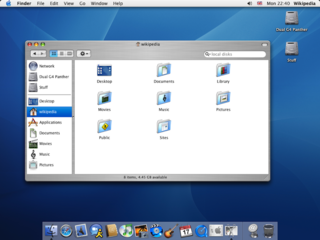 W
WMac OS X Panther is the fourth major release of Mac OS X, Apple's desktop and server operating system. It followed Mac OS X 10.2 and preceded Mac OS X Tiger. Apple released Panther on October 24, 2003.
 W
WMac OS X Tiger is the fifth major release of Mac OS X, Apple's desktop and server operating system for Mac computers. Tiger was released to the public on April 29, 2005 for US$129.95 as the successor to Mac OS X 10.3 Panther. Some of the new features included a fast searching system called Spotlight, a new version of the Safari web browser, Dashboard, a new 'Unified' theme, and improved support for 64-bit addressing on Power Mac G5s. Mac OS X 10.4 Tiger offered a number of features, such as fast file searching and improved graphics processing, that Microsoft had spent several years struggling to add to Windows with acceptable performance.
 W
WMac OS X Leopard is the sixth major release of Mac OS X, Apple's desktop and server operating system for Macintosh computers. Leopard was released on October 26, 2007 as the successor of Mac OS X 10.4 Tiger, and is available in two editions: a desktop version suitable for personal computers, and a server version, Mac OS X Server. It retailed for $129 for the desktop version and $499 for Server. Leopard was superseded by Snow Leopard. Leopard is the final version of macOS to support the PowerPC architecture as Snow Leopard functions solely on Intel based Macs.
 W
WNetBSD is a free and open-source Unix-like operating system based on the Berkeley Software Distribution (BSD). It was the first open-source BSD descendant officially released after 386BSD was forked. It continues to be actively developed and is available for many platforms, including servers, desktops, handheld devices, and embedded systems.
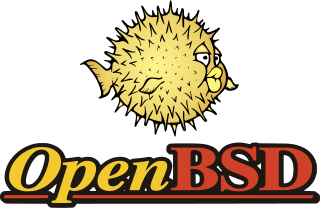 W
WOpenBSD is a security-focused, free and open-source, Unix-like operating system based on the Berkeley Software Distribution (BSD). Theo de Raadt created OpenBSD in 1995 by forking NetBSD. According to the website, the OpenBSD project emphasizes "portability, standardization, correctness, proactive security and integrated cryptography."
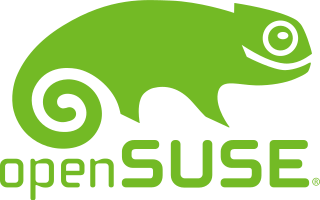 W
WopenSUSE, formerly SUSE Linux, is a Linux distribution sponsored by SUSE Software Solutions Germany GmbH and other companies. Its "Leap" variant shares a common code base with, and is a direct upgradable installation for the commercially-produced SUSE Linux Enterprise, effectively making openSUSE Leap a non-commercial version of the enterprise product. It is widely used throughout the world. The focus of its development is creating usable open-source tools for software developers and system administrators, while providing a user-friendly desktop and feature-rich server environment.
 W
WPlan 9 from Bell Labs is a distributed operating system, originating in the Computing Science Research Center (CSRC) at Bell Labs in the mid-1980s, and building on UNIX concepts first developed there in the late 1960s. The final official release was in early 2015.
 W
WSystem 7, codenamed "Big Bang", and also known as Mac OS 7, is a graphical user interface-based operating system for Macintosh computers and is part of the classic Mac OS series of operating systems. It was introduced on May 13, 1991, by Apple Computer, Inc. It succeeded System 6, and was the main Macintosh operating system until it was succeeded by Mac OS 8 in 1997. Features added with the System 7 release included virtual memory, personal file sharing, QuickTime, QuickDraw 3D, and an improved user interface.
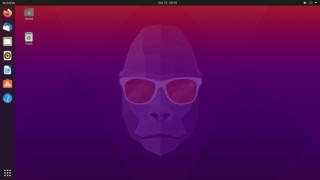 W
WUbuntu is a Linux distribution based on Debian and mostly composed of free and open-source software. Ubuntu is officially released in three editions: Desktop, Server, and Core for Internet of things devices and robots. All the editions can run on the computer alone, or in a virtual machine. Ubuntu is a popular operating system for cloud computing, with support for OpenStack. Ubuntu's default desktop has been GNOME, since version 17.10.
 W
WUSU linux is Bulgarian open source desktop operating system built around the KDE desktop environment and based on the popular free Linux distribution, Ubuntu.
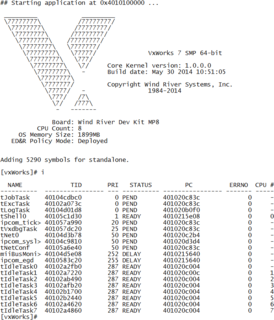 W
WVxWorks is a real-time operating system (RTOS) developed as proprietary software by Wind River Systems, a wholly owned subsidiary of TPG Capital, US. First released in 1987, VxWorks is designed for use in embedded systems requiring real-time, deterministic performance and, in many cases, safety and security certification, for industries, such as aerospace and defense, medical devices, industrial equipment, robotics, energy, transportation, network infrastructure, automotive, and consumer electronics.
 W
WWindows NT 3.51 is the third release of Microsoft's Windows NT line of operating systems. It was released on May 30, 1995, nine months after the release of Windows NT 3.5, and three months before the release of Windows 95. The most significant enhancement offered in this release was that it provides client/server support for inter-operating with Windows 95, which was released three months after NT 3.51. Windows NT 4.0 became its successor a year later. Support for NT 3.51 ended in 2001 and 2002 for the Workstation and Server editions, respectively.
 W
WWindows NT 4.0 is an operating system that is part of Microsoft's Windows NT family of operating systems. It was released to manufacturing on July 31, 1996, and was launched to retail on August 24, 1996. It was Microsoft's primary business-oriented operating system until the introduction of Windows 2000. Workstation, server and embedded editions were sold; all editions feature a graphical user interface similar to that of Windows 95.
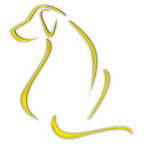 W
WYellow Dog Linux (YDL) was a free and open-source operating system for high-performance computing on multi-core processor computer architectures. It focuses on GPU systems and computers using the POWER7. YDL was developed by Fixstars. Yellow Dog Linux was first released in the spring of 1999 for the Apple Macintosh PowerPC-based computers. The most recent version, Yellow Dog Linux 7, was released on August 6, 2012. Yellow Dog Linux lent its name to the popular YUM Linux software updater, derived from YDL's YUP and thus called Yellowdog Updater, Modified.